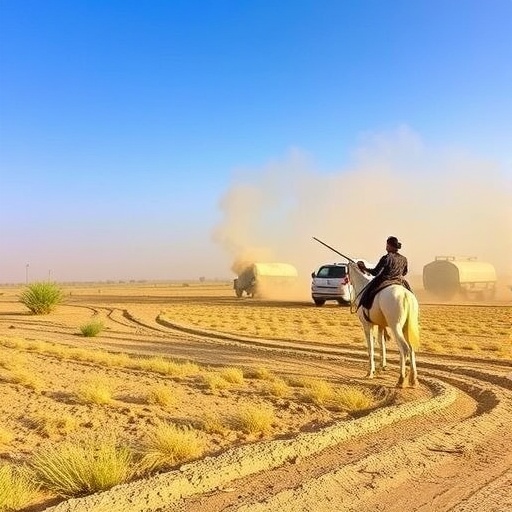Amid California’s ongoing struggles with environmental and public health challenges, a newly published study unveils a critical and previously underappreciated contributor to the state’s worsening dust problem: fallowed agricultural lands. Conducted by researchers at the University of California, Merced, the investigation reveals that more than one million acres of idled farmland annually generate significant quantities of dust, posing serious implications not only for human health but also for California’s climate and agricultural productivity.
The comprehensive study, featured in the April 2025 edition of Communications Earth & Environment, spotlights the Central Valley—a region traditionally overlooked as a major dust source—as the predominant origin of dust events linked to agricultural activity. Remarkably, the Central Valley is responsible for approximately 77% of California’s fallowed land acreage and accounts for about 88% of the state’s anthropogenic dust emissions. This finding fundamentally shifts current understanding of dust generation patterns within the region and underscores the pivotal role farming practices and land management decisions play in exacerbating environmental hazards.
At the heart of this issue is the practice of leaving farmland fallow, a decision that often arises from water supply limitations or economic constraints. In counties such as Kern, Fresno, and Kings—home to large expanses of wheat, corn, and cotton fields—annual crops are regularly left unplanted. While fallowing may serve agricultural or regulatory purposes, the resultant exposed soil surfaces become vulnerable to wind erosion. Strong regional winds lift these fine particles into the atmosphere, fueling dust storms that can span vast areas, diminish air quality, and disrupt daily life for millions.
The health repercussions linked to dust exposure are severe and multifaceted. Dust carries a cocktail of chemical residues and biological agents, including fungal spores responsible for respiratory illnesses like Valley fever. The particulate matter in dust is associated with a broad spectrum of serious medical conditions ranging from chronic obstructive pulmonary disease (COPD) and asthma to cardiovascular ailments and certain neurological disorders such as dementia. Intriguingly, emerging evidence also correlates dust exposure with reproductive health challenges, including longer and more painful menstrual cycles, highlighting a complexity of impacts previously underrecognized. Importantly, these health effects disproportionately affect vulnerable populations, compounding social and environmental inequities.
Beyond direct human health, dust storms contribute to a host of secondary hazards. Decreased visibility during dust events has been implicated in a discernible uptick in fatal traffic accidents, signaling a public safety crisis linked to environmental phenomena. Agricultural productivity itself suffers as nutrient-rich topsoil erodes, and airborne particulates abrade crops, diminishing yields. Considering California’s role as the nation’s leading agricultural producer, these soil losses carry profound economic and food security ramifications.
Climatologists involved in the research note an additional, climate-relevant consequence of dust deposits—the alteration of snowpack dynamics in the Sierra Nevada mountains. Dust settling on snow surfaces reduces albedo by darkening the snow, accelerating melt rates and altering the timing and quantity of runoff. Given that the Sierra Nevada snowpack constitutes a crucial freshwater reservoir for California, these changes threaten water availability and management across the state, particularly during increasingly volatile climatic conditions.
Temporal and spatial analyses reveal that while fallowed land acreage naturally fluctuates due to crop rotation schedules, a troubling expansion of idled farmland has occurred over the past decade and a half, from 2008 to 2022. This trend aligns temporally with the implementation of the Sustainable Groundwater Management Act (SGMA), legislation designed to curb overextraction of groundwater by limiting agricultural water use. Despite the law’s environmental intent, these new restrictions have inadvertently increased the extent of unplanted, exposed fields, thereby escalating dust generation.
The unintended consequences of SGMA present a complex policy challenge. While groundwater conservation is integral to California’s long-term environmental resilience, mitigating the collateral impacts of large-scale fallowing necessitates targeted strategies to control wind erosion. Researchers advocate adopting cover crops or other forms of continuous ground cover to stabilize soil structure and enhance soil organic matter. Such practices can suppress dust emissions by binding soil particles and reducing surface exposure to erosive forces without compromising water savings.
Meteorologically, the occurrence of widespread dust storms is generally precipitated by strong winds or episodic storm events. However, the presence of dry, disturbed soils—primarily resulting from human agricultural activity—significantly increases the likelihood and intensity of dust mobilization. This human dimension differentiates anthropogenic dust from naturally occurring sources and underscores the relevance of land management in environmental health interventions.
The team emphasizes the necessity of sustained research endeavors to elucidate the complex interactions between dust, climate, and human health. Collaborative efforts, including the recently established UC Dust coalition, leverage interdisciplinary expertise to better characterize dust impacts and inform effective regional mitigation strategies. Such initiatives aim to generate predictive models and evidence-based policies that can be adopted statewide and serve as templates for dust-affected regions globally.
Ultimately, the study challenges conventional paradigms that have undervalued California’s Central Valley as a dust hotspot. Adeyemi Adebiyi, a lead investigator, stresses that understanding agricultural fallowing as a dominant source of anthropogenic dust compels a reevaluation of how dust-related environmental and health impacts are quantified. This paradigm shift holds promise for refining climate models, improving public health risk assessments, and shaping adaptive management in agricultural regions worldwide.
Looking ahead, one of the most pressing unknowns lies in anticipating how agricultural dust sources may evolve under changing climatic and regulatory environments. The study’s insights lay foundational knowledge for forecasting shifts in dust emissions, thus enhancing the predictive capacity of climate and environmental health models. By linking land use, water policy, and atmospheric processes, this research articulates a critical nexus between human decision-making and environmental sustainability in California and beyond.
Subject of Research:
Fallowed agricultural lands as dominant sources of anthropogenic dust emissions in California
Article Title:
Fallowed agricultural lands dominate anthropogenic dust sources in California
News Publication Date:
26-Apr-2025
Web References:
https://www.nature.com/articles/s43247-025-02306-0
http://dx.doi.org/10.1038/s43247-025-02306-0
Keywords:
Farming, Agriculture, Anthropogenic dust, Central Valley, Air quality, Soil erosion, Sustainable Groundwater Management Act, Climate impacts, Health effects




